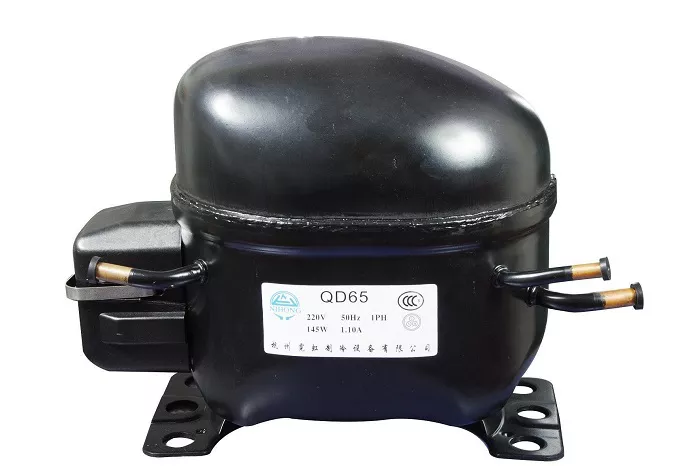A refrigerator compressor is the heart of the cooling system, responsible for circulating refrigerant and maintaining the desired temperature. Understanding its internal components and operation is crucial for technicians, engineers, and anyone interested in refrigeration technology.
Basic Function of a Refrigerator Compressor
The compressor’s primary role is to increase the pressure and temperature of the refrigerant gas, allowing it to release heat in the condenser and absorb heat in the evaporator.
Key Responsibilities
- Compresses low-pressure refrigerant vapor from the evaporator.
- Pumps high-pressure refrigerant to the condenser.
- Maintains continuous flow in the refrigeration cycle.
Without a functioning compressor, the fridge cannot cool properly.
Types of Compressors Used in Refrigerators
Reciprocating (Piston) Compressor
- Uses a piston-cylinder mechanism to compress refrigerant.
- Common in older and some modern fridges.
- Pros: Simple design, cost-effective.
- Cons: More moving parts, higher wear and tear.
Rotary Compressor
- Uses a rotating mechanism (vane or rolling piston) to compress gas.
- Found in many modern refrigerators.
- Pros: Quieter, more efficient, fewer moving parts.
- Cons: More expensive to repair.
Scroll Compressor
- Uses two spiral-shaped scrolls (one fixed, one orbiting) to compress refrigerant.
- Less common in household fridges, more in commercial units.
- Pros: High efficiency, smooth operation.
- Cons: Complex manufacturing, costly.
For this article, we focus on reciprocating and rotary compressors, as they are most prevalent in household refrigerators.
Internal Components of a Fridge Compressor
Hermetic Shell
- Made of steel to withstand high pressure.
- Sealed permanently to prevent refrigerant leaks.
- Contains motor, compression mechanism, and oil sump.
Electric Motor
- Stator (stationary windings)
- Rotor (rotating part connected to the crankshaft)
Compression Mechanism
- Piston & Cylinder: Compresses refrigerant gas.
- Crankshaft: Converts rotary motion into piston movement.
- Connecting Rod: Links piston to crankshaft.
- Valves (Suction & Discharge): Control refrigerant flow.
In Rotary Compressors
- Rolling Piston: Rotates eccentrically to compress gas.
- Vanes: Slide to maintain sealing.
Lubrication System
- Oil Sump: Stores lubricating oil at the bottom.
- Oil Pump (or Splash Lubrication): Distributes oil to moving parts.
- Oil Return System: Ensures oil circulates back.
Suction & Discharge Tubes
- Suction Tube: Draws low-pressure gas from evaporator.
- Discharge Tube: Pumps high-pressure gas to condenser.
Overload Protector & Start Relay
- Overload Protector: Prevents motor burnout due to overheating.
- Start Relay: Helps motor start by providing initial torque.
Electrical and Mechanical Operation
Starting the Compressor
- Power Supply: Start relay activates.
- Motor Windings generate magnetic field: rotor spins.
- Crankshaft moves: piston/rotary mechanism compresses gas.
Running Cycle
- Continuous compression as long as the thermostat demands cooling.
- Overload protector monitors temperature and current.
Shutting Down
- Thermostat cuts power when desired temperature is reached.
- Compressor stops until next cooling cycle.
Common Failures and Maintenance Tips
Common Compressor Failures
Electrical Failure
- Burned-out motor windings.
- Faulty start relay or capacitor.
Mechanical Failure
- Seized piston (lack of lubrication).
- Broken valves (poor refrigerant flow).
Refrigerant Leaks
- Low refrigerant: compressor overworksfailure.
Oil Breakdown
- Contamination or loss: increased friction.
Maintenance Tips
- Avoid frequent on/off cycles (causes stress).
- Ensure proper voltage supply (low voltage damages motor).
- Check for refrigerant leaks (hissing sounds, poor cooling).
- Keep condenser coils clean (prevents overheating).
Conclusion
A refrigerator compressor is a complex electromechanical device with precise components working in harmony. Understanding its internal structure, operation, and failure modes helps in proper maintenance and troubleshooting.
By following best practices, a fridge compressor can last 10-15 years or more. For major repairs, always consult a qualified refrigeration technician.

